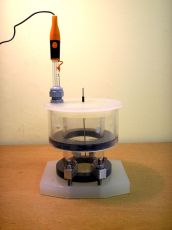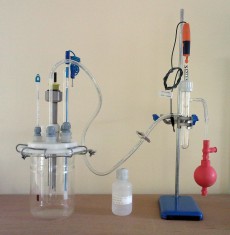Bubble Test Cell

The Bubble test cell has been designed for the every day testing of oilfield inhibitors on steel. It is suitable for standard Bubble test work or for LCM™ techniques that in addition to the average corrosion rate vs. time gives information pertaining to localised corrosion. The cell is a Quickfit 1 litre reaction vessel with lid and clamp. Several ports are available in the lid for gas injection via a 7mm glass tube, an exhaust, inhibitor injection port with plug and a central chemical resistant three electrode probe. Two versions of probe are available, the ACMP4 probe is supplied with three electrodes, two of which are made from Hastelloy on a 3mm thread, whilst the working electrode, typically made from a mild steel, is on a 440UNC thread. The intention is to reduce costs in that only the working electrode needs to be replaced between tests, whilst the Hastelloy auxiliary and reference electrodes only need to be cleaned. The ACMP3 probe is supplied with three electrodes, two of which are made from mild steel on a 440UNC thread for the working and reference electrodes, the third is made from Hastelloy on a 3mm thread.
For suitable instrumentation see our Gill 6 / 8 / 12
Cathodic Disbondment Test Cell

The Cathodic Disbondment Test Cell has been designed for testing of coatings. It accommodates a 15cm x 10cm painted test panel, which can also easily be attached to rounded pipes, via silicone sealant. The cell is supplied with the reference electrode and platinised titanium auxiliary electrode.
Electrochemical Cell Kit

The 1 Litre Quickfit type Electrochemical Cell is supplied with the following: Sealed 1 Litre Reaction Vessel; Platinum Band Type Auxiliary Electrode; Saturated Calomel Reference Electrode; Reservoir; Luggin Probe with Tubing; Platinum Mains Noise Reduction Electrode; Retort Stand; 0-105°C Thermometer; Glass Frit; Exhaust and a two Electrode Probe. The retractable probe fits in the centre of the cell and accommodates two standard 4.75cm2 screw on electrodes for galvanic C&V noise or 2 electrode LPR studies. The access hole in the centre of the cell which is normally used for the 2 electrode probe is supplied with an adapter for fitting of other probe types to suit your requirements. The adapter supplied with the Luggin probe can be removed in order to directly place the reference electrode into the cell.
Simplified Electrochemical Cell Kit
The 1 Litre Quickfit type Electrochemical Cell is supplied with the following: Sealed 1 Litre Reaction Vessel; Platinum Band Type Auxiliary Electrode; Saturated Calomel Reference Electrode; 0-105°C Thermometer; Glass Tube; Exhaust and a two electrode probe. The retractable probe fits in the centre of the cell which accommodates two standard 4.75cm² screw on electrodes. The access hole in the centre of the cell which is normally used for the 2 electrode probe is supplied with an adaptor for fitting of other probe types to suit your requirements.
Probes and electrodes
ACMP4 - Industry standard 3 pin probe for bubble tests. The probe is equipped with one 440UNC pin for a mild steel working electrode and two 3mm pins for Hastelloy reference and auxiliary/counter electrodes.
ACMP3 - An alternative to the ACMP4 where the Hastelloy reference electrode is replaced by a 440UNC mild steel electrode
ACMP2 - Two pin probe with 440UNC pins for mild steel electrodes.
ACMP1 - Two pin probe with 3mm pins for customers who prefer 3mm electrodes.
ACMP5 - Three pin probe with 3mm pins for customers who prefer 3mm electrodes.
Probes are made from PEEK. Connections are made via 4mm sockets on trailing leads. Amphenol connections are available by adding the suffix "A" to the part numbers (e.g, ACMP4A).
Mild Steel 440UNC electrodes with an electrode area of 4.75cm².
Hastelloy 3mm electrodes with an electrode area of 4.75cm².
Custom probes and electrodes are available on request. Contact Andrew for more details.
Noise Reduction Probe
Noise Reduction Probes can reduce mains signal polarisation of your test electrodes from as much as a few volts to just a few mV’s. The root cause of this problem is the different levels of mains pick up between the reference electrode and the test electrode. In a simple cell where the reference electrode is just a piece of metal immersed in the bulk test solution mains pick up is not generally a significant problem. The problem arises when the reference electrode is in its own separate solution. This is true for typical commercial reference electrodes and especially for any remote reference electrode connected to the cell via a salt bridge. For more information please view application notes for the noise reduction probe.
Saturated Calomel Electrode
Silver Chloride Electrode
Platinum Band Auxiliary Electrode
Hot Plate with Remote Temperature Sensor

Model and specifications may vary depending on availability or customers requirements.
H-Cell

Two 1 Litre Quickfit type electrochemical cells connected by a glass tube with a sintered glass barrier.
